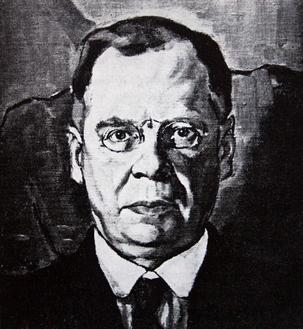Related Research Articles

Gustav Schoeman Preller was a journalist, historian, writer and literary critic. He fought for the recognition of Afrikaans. Preller helped the Afrikaner to realize the importance of the history of South Africa. He made great contributions to the writing of South African history, through his research and literature. He also contributed greatly to making South Africans aware of the legacy of the Voortrekkers and also played an early part in planning the Voortrekker Monument.
Dr. Daniel Hugo is a poet, translator, compiler and editor. He worked a specialist announcer / producer for Radiosondergrense, the national Afrikaans radio service, and was also responsible for the literary programmes "Leeskring" and "Vers en Klank". He is an edit at the publishing house Protea Boekhuis.
The Hertzog Prize is an annual award given to Afrikaans writers by the Suid-Afrikaanse Akademie vir Wetenskap en Kuns, formerly the South African Academy for Language, Literature and Arts. It is the most prestigious prize in Afrikaans literature.
Albertha Magdalena Bouwer was a South African Afrikaans-writing journalist and author. She is best known for her series of children's stories about the experiences of a small girl called Alie growing up in the fictional location Rivierplaas in rural Free State. Late in life she published a novel for adults, Die afdraand van die dag is kil, about two women in old age.

Hendrik Bernardus Thom was a Afrikaner professor and former Rector of the Stellenbosch University.
Bernard Lewis was a Jewish South African art critic, journalist, and author.

Daniël Cornelis Boonzaier, more commonly known as D.C. Boonzaier, was a South African cartoonist. He was famous for his caricatures of Cape politicians and celebrities at the turn of the century, and later for his anti-capitalist and anti-imperialist cartoons for Die Burger. He fathered the artist Gregoire Boonzaier.

The Suid-Afrikaanse Akademie vir Wetenskap en Kuns (SAAWK) is a multidisciplinary organization dedicated to promoting science, technology and the arts in Afrikaans, as well as promoting the use and quality of Afrikaans. The Hertzog Prize is awarded annually by the academy for high-quality literary work, while the Havenga prize is awarded annually for original research in the sciences.

Israel-Isaac Lipshitz, known as Lippy Lipshitz was a South African sculptor, painter and printmaker. He is considered to be one of the most important South African sculptors, along with Moses Kottler and Anton van Wouw.

Moses Kottler (1896–1977) was a South African painter and sculptor. He is widely regarded, along with Anton van Wouw and Lippy Lipshitz, as one of the most important South African sculptors. This triumvirate had the distinction of also having excelled at using pictorial media; Lipshitz with monotypes and Van Wouw in painting and drawing. Kottler's work in oils earned him additional consideration as a painter.

A tameletjie is a homemade toffee confection which features prominently within the Afrikaner and Malay cultures of South Africa. The sweet is made from sugar and water which has been boiled until caramelized and then rested to cool to form a hard sweet. There are many variations to the sweet attained by adding almonds, pine nuts or coconut to the recipe.
Johannes Jacobus (Johan) Degenaar OIS was a South African philosopher, and Emertitus Professor at the Stellenbosch University, who is considered "one of the most respected and influential philosophers in South Africa."
Hester Henriette Grové(née Venter) was a South African writer of African origin. She was married to the literary critic A.P. Grové.
Marthinus Versfeld was a South African philosopher. From 1937 to 1972 he taught at the University of Cape Town. He was celebrated as researcher, enjoyed the recognition of the South African literary community and was known as an opponent of the Apartheid system. His work ranged from scholarly books to playful essays on issues like ethics, anthropology, the meaning of life.
S. V. Petersen was an Afrikaans-language South African poet and author, educator and founding principal of the Athlone High School, Silvertown Athlone, Cape Town. He was the first person of colour whose poetry and prose were published in South Africa.
Tydskrif vir Letterkunde is a peer-reviewed academic journal covering African literature. The editor-in-chief is Hein Willemse.

Gordon Tomlinson was a lawyer, writer, and champion of Afrikaans.
Johannes Petrus Spies was a Namibian author and popular storyteller. Alongside P.G. du Plessis he was the presenter of the popular television program Spies en Plessie – met permissie, and hosted personalities like Tolla van der Merwe, Koos Meyer, Danny Pretorius, Nico Nel and Pyp de Villiers.
Madelene Olivier Van Aardt was a South African composer, teacher, and pianist. She was one of the few women to compose songs in the Afrikaans language.

Marie Linde was the pen name of Elizabeth Johanna Bosman, a South African novelist of Afrikaner descent. Initially home schooled, she studied modern languages at the University of Cape Town and was an accomplished linguist, able to speak Dutch, German, French and English. She published novels, short stories and plays, and created the first Afrikaans radio play broadcast. Published in 1925, her novel Onder bevoorregte mense was the first Afrikaans novel translated into English, being issued as Among Privileged People.
References
Giliomee, J. H. 1990. "Die kunsversameling van prof. J. du P. Scholtz." Tydskrif vir geesteswetenskappe 30: 46–53.
Muller Ballot, G. 1980. "J. du P. Scholtz as kunshistorikus." Standpunte 33(3): 14–24.
Nel, Marieta. 1990. 'n Ondersoek na die taal- en literêr-historiese arbeid van J. du P. Scholtz. Unpublished dissertation, University of Cape Town.
Raidt, Edith. 1980. "J. du P. Scholtz - Taalwetenskaplike." Standpunte 33(3): 2-14.
Raidt, Edith. 1990. Obituary, J. du P. Scholtz. Jaarboek van die Suid-Afrikaanse Akademie vir Wetenskap en Kuns, 1990.